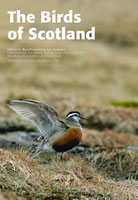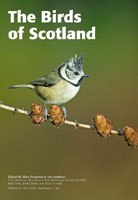The Birds of Scotland
The Birds of Scotland edited by Ron Forrester, Ian Andrews et al.
 I am the proud owner of a copy of the original Misses Baxter and Rintoul's 1953 version of the Birds of Scotland. That is a work of great charm, starting with a poem, and leaving the mind boggling at the outrageous amount of work and research that these two indomitable ladies managed to do between them. I was therefore intrigued and eager to get my hands on this new Scottish avifauna.
I am the proud owner of a copy of the original Misses Baxter and Rintoul's 1953 version of the Birds of Scotland. That is a work of great charm, starting with a poem, and leaving the mind boggling at the outrageous amount of work and research that these two indomitable ladies managed to do between them. I was therefore intrigued and eager to get my hands on this new Scottish avifauna.
I had explored the book's website before I trekked north to Edinburgh to pick up my copy, but it did not prepare me for the sheer scale and beauty of this publication. An inauspicious, but huge and heavy, brown cardboard box opened to reveal a carefully nested sturdy green slip case, housing two gorgeous, full-colour A4 hardback volumes (one Dotterel, one Crested Tit covered), carefully wrapped in tissue paper. The sort of packaging that makes you think that you are in for a treat.
 If anything, I underestimated the treat I was in for. All 514 species ever seen in Scotland are each allocated a minimum of one (and in some cases six) pages. The vast majority of the accounts have at least one photo, and the few vagrants that weren't photographed are illustrated in pen-and-ink drawings by John Busby, Tommy Daniels and others. The photographs are, in the vast majority, a delight in themselves. I am astounded at the number of species that the editors managed to source photos of, and the inclusion of species such as Tree Swallow has to be admired, even if the record shots don't make for the most aesthetic examples.
If anything, I underestimated the treat I was in for. All 514 species ever seen in Scotland are each allocated a minimum of one (and in some cases six) pages. The vast majority of the accounts have at least one photo, and the few vagrants that weren't photographed are illustrated in pen-and-ink drawings by John Busby, Tommy Daniels and others. The photographs are, in the vast majority, a delight in themselves. I am astounded at the number of species that the editors managed to source photos of, and the inclusion of species such as Tree Swallow has to be admired, even if the record shots don't make for the most aesthetic examples.
Resident and regularly occurring species are treated in a logical way: name, scientific name, Gaelic name, population statistics, importance level and main threats. The world range and taxonomy is then described, followed by habitat, Scottish range, distributions and status, breeding cycle, detailed population, trends, threats and the important gaps in current knowledge. This lends the volumes clarity, and makes it quick and easy to find data and pieces of information. Vagrants are, as one would expect, treated rather more concisely, with a useful comments section containing historical snippets. I was initially slightly perplexed to find Anseriformes and Galliformes at the beginning of the species accounts, and still have to think twice about where I might find a grouse, but this is a minor quibble.
You can view PDF versions of the White-tailed Eagle and Evening Grosbeak accounts as examples.
There are twelve introductory chapters that serve as a rich and detailed background to the species accounts. Covering habitat and geography, weather and migration, recording and conservation; they are well written and an enjoyable read. Also included are fascinating chapters on some slightly less expected topics such as the fossil record, early bird photography and some of the pioneers of Scottish birding. Furthermore there are seven appendices, including a 2005-6 update and a summary of population estimates, as well as a 74-page bibliography of over 5,800 references - a testament to the amount of scholarly work that has gone into this tome.
Let me highlight a few of the species accounts that I think give a taste of what makes this book special:
- The thorny issue of Crossbills comes to mind immediately. Here we find wonderful comparative head photos illustrating bill structure, sonograms of calls, and recent DNA studies. I will leave you, dear reader, to draw your own conclusions from the comprehensive data presented.
- The Wren is split into British, Shetland, Fair Isle, Hebridean, St Kilda and European subspecies, and a wealth of information is available on each.
- The currently topical Night Heron entry contains an useful section on the Edinburgh Zoo population.
- The comments section of the Great Bustard entry manages to introduce the reader to an archaeological phenomenon called the "schlepp effect", inform us that this bird tastes rather like jugged hare, despite having an unpleasant aromatic odour, and then goes on to describe the known tendency of females to be more prone to wander than males.
- Success stories such as Corncrake are described, as are some less edifying statistics such as the ongoing demise of the Black Grouse.
- Seawatchers will delight in the detailed time-and-place breakdown of Pomarine and Long-tailed Skua passages.
The SOC are to be congratulated on producing a beautiful book: well written, clearly presented, nicely laid out, and wonderfully packaged. It deals comprehensively with the Scottish avifauna, including several subspecies that, to my lasting shame, I was unaware of. It is up to date, embraces the latest scientific techniques, and will no doubt be heavily referenced in the next edition of BWPi! At £75 it represents astonishing value for money. It is a work of great scientific value, but is also a lovely, lovely thing - to be dipped into, leafed through and learned from. Anybody with a serious interest in British birds should certainly have a copy. As climate change takes its toll, it is Scotland that may well suffer first.
Editors in full: Ron Forrester, Ian Andrews, Christopher McInerny, Ray Murray, Robert McGowan, Bernard Zonfrillo, Michael Betts, David Jardine and David Grundy.
Publisher: The Scottish Ornithologists' Club
Hardcover, A4 size, 2 volumes in slip case, pp 1632
RRP £75 (plus £10 UK p&p) ISBN-13: 978-0-9512139-0-2 (set)
You can buy the Birds of Scotland here.


